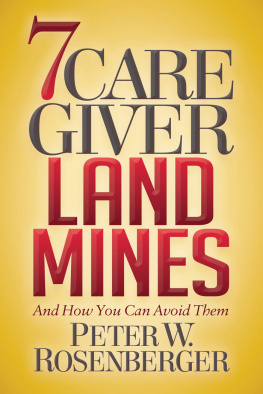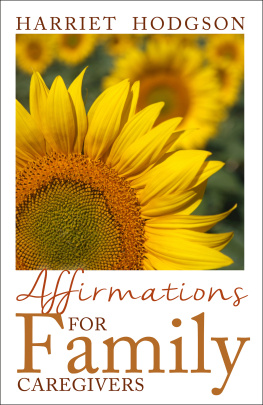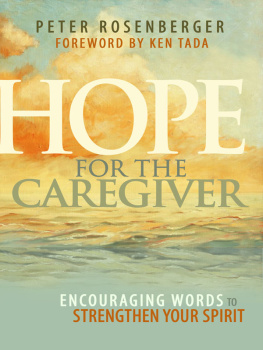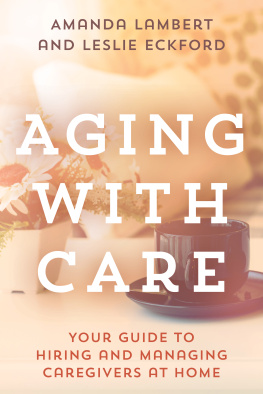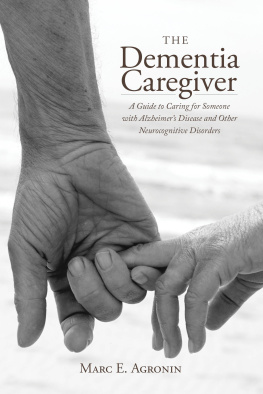CAREGIVER LANDMINES
CAREGIVER
LANDMINES
And How You Can Avoid Them
P ETER W. R OSENBERGER

NEW YORK
LONDONNASHVILLEMELBOURNEVANCOUVER
CAREGIVER LANDMINES
And How You Can Avoid Them
2019 P ETER W. R OSENBERGER
All rights reserved. No portion of this book may be reproduced, stored in a retrieval system, or transmitted in any form or by any meanselectronic, mechanical, photocopy, recording, scanning, or otherexcept for brief quotations in critical reviews or articles, without the prior written permission of the publisher.
Published in New York, New York, by Morgan James Publishing. Morgan James is a trademark of Morgan James, LLC. www.MorganJamesPublishing.com
The Morgan James Speakers Group can bring authors to your live event. For more information or to book an event visit The Morgan James Speakers Group at www.TheMorganJamesSpeakersGroup.com.
ISBN 978-1-64279-001-6 paperback
ISBN 978-1-64279-002-3 eBook
Library of Congress Control Number: 2018935511
| Cover Design by: | Interior Design by: |
| Rachel Lopez | Bonnie Bushman |
| www.r2cdesign.com | The Whole Caboodle Graphic Design |

In an effort to support local communities, raise awareness and funds, Morgan James Publishing donates a percentage of all book sales for the life of each book to Habitat for Humanity Peninsula and Greater Williamsburg.
Get involved today! Visit
www.MorganJamesBuilds.com
Introduction
What does it feel like to be a caregiver?
Its kind of like coming to a road, looking both waysand then getting hit by a plane!
For more than thirty years, Ive been a caregiver for my wife through a medical nightmare that continues to bring new challengesoften daily. This journey shows no signs of slowing down. Along the way, Ive had ample time to make virtually every mistake one can make as a caregiver.
Through this journey and through all the mistakes, Ive also gained hard-won wisdom and experienced teachable lessons on the challenges, predicaments, and heartache of the caregiver. One of those teachable moments came following a snowmobile excursion in the forests of Montana with our youngest son, Grayson.
Ten miles from the paved road in a tiny town in Montana, my in-laws home backs up to the national forest. No stranger to snowmobiles, Grayson and I headed into the mountains and traveled deep into the vast Montana wilderness one afternoon. Trails are marked by reflectors posted periodically on trees, and if you are not paying attention, it can be easy to miss one of those markers.
Although logging many hours on those trails, this day was a windy one, and the fresh snow covered any tracks made by previous riders. Speeding along the trail, I missed a marker. Finding ourselves on a slope, in a deep snow drift, my machine sank into the soft powder and quickly became stuck.
Getting a sled out of deep snow is not too bad if you have two people, but to complicate matters, we were lost. Wed have to work to get the machine freed and somehow make it back up the hill (in the soft snow) and find the marker. So, if we spent all our energy digging the machine out of the snow, we still ran the risk of getting stuck in an even worse placeunless we knew where the trail lay and could get our bearings there.
As we pondered our situation, the sun slowly sank over the peaks, and the temperature dropped. The wind howled, and snow whipped around us. I admit feeling more than a little unsettled. Not thinking about the house, not even thinking about five miles down the mountain, I simply wanted to find that next marker. The only goal was to navigate to a place of safety and get my bearings.
After a systematic search using Graysons machine, which he kept away from the soft drifts, we found the marker. Then, we worked together to free my sled from the deep snow. With my heart racing, I gunned the machine, felt it take hold, and made a beeline for the marker and the trailwhere I knew the packed snow would make it easier to navigate and provide a haven to catch my breath. Successfully feeling the packed snow of the trail, Grayson and I safely headed down the mountain.
Now, how does any of this relate to this bookand why was this a teachable moment for me as a caregiver?
As caregivers, we often find ourselves stuck in precarious circumstances, with deteriorating situations. Even if we spent the resources (money, energy, time) to get unstuck, we dont often know where the path to safety lies, and we risk getting into an even worse spotwith fewer resources.
We need to find the marker and catch our breath.
As caregivers, we often cant think years, months, or even weeks down the road. All we can do is take the next right step, stay on a path to safety, and follow the markers to stay on a trail that is often hard to see.
In that snow-covered field, I couldnt simply walk around. The snow was so soft that I sank up to my waist at times and had to be careful where I stepped. Each time I floundered in the snow, I risked getting hurt, wasting precious energy, stepping into a covered hole, and even compromising the ability of my son to help me.
The road of a caregiver also has landmines. Not actual explosives, of course, but beliefs and behaviors that cause serious damage to a caregiver, as well as to that caregivers loved one. So not only do we need to know where the path to safety is, we need to know how to avoid those dangerous landmines that can cripple caregivers.
Thats what this book is all about. In this book, we will discuss seven caregiver landmines that can wreak havoc in a caregivers lifeand the life of the caregivers vulnerable loved one.
Despite all our skills, blinding speed, and apparent competency, all caregivers suffer from the same challenge: what we do is unsustainable. Its simply a matter of time before a caregivers body, emotions, and/or wallet break down.
When caregivers recklessly hurl themselves at managing that which cannot be managed, we rely on two things: our own abilities and the belief that we will outlive our loved ones.
Both beliefs create a serious risk of harming the very people we seek to serve. If the caregiver goes down, this has disastrous implications for the loved one who is already vulnerable.
Yet, we caregivers tend to white-knuckle through the brutal timeswhile taking physical and emotional shortcuts for our own health. On that snow-covered field, there were no shortcuts. There was only one path, and I had to think it through; look for the marker and then make a beeline for it. I knew the general direction of the house, but between me and that ten-mile expanse lay even more dangerous places. Consequently, the only way I could safely get off that mountain was to find the marker and get back on the trail.
I point caregivers to the next marker and help them make a beeline for safety. While the end of the trail for us as caregivers is uncertain, there is no doubt, however, that our loved ones will suffer even worse than they do now if we as caregivers are not in a safe and healthy place today.
One of the advantages of serving as a caregiver for as long as I have is that Ive had ample time to make about every mistake possible as a caregiver.
The dark roads are familiar to me, and I recognize dead-ends and cul-de-sacs. And Ive got the scars to prove my experience with caregiver landmines.
You dont have to get those scarsbut even if you do have them, you dont have to keep getting injured by the same landmines.

